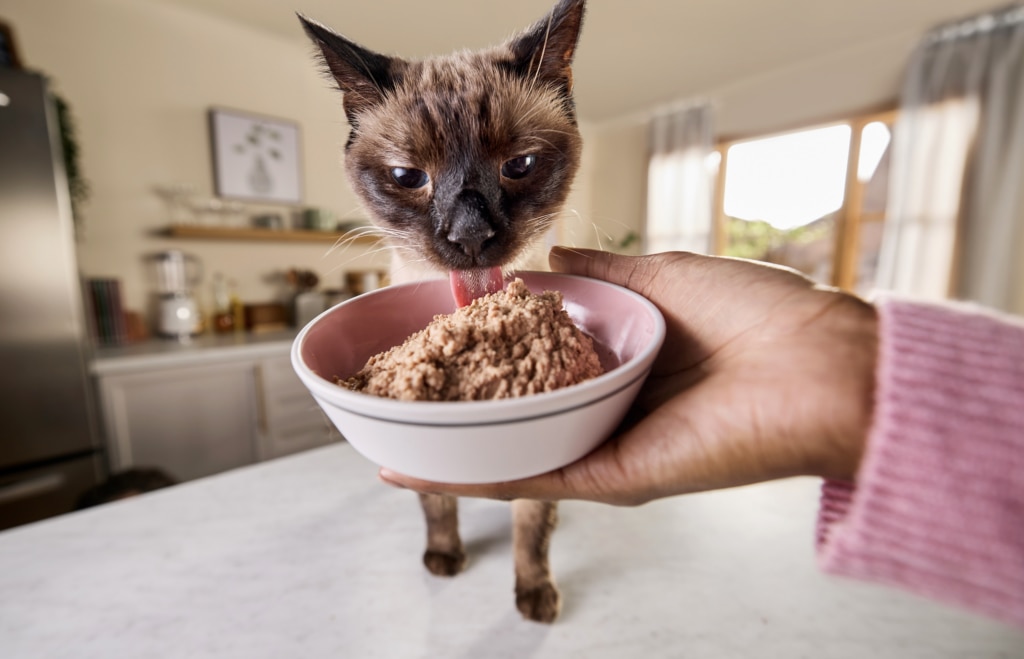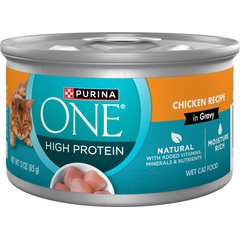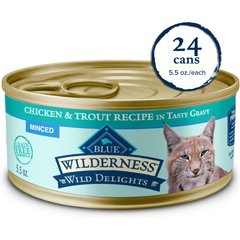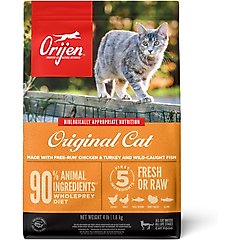Does Your Cat Need a High-Protein Cat Food?

Photo by Chewy
Cats are obligate carnivores—that means their bodies are designed to thrive on a meat-based diet and they need it to survive.
So, an animal-based protein isn’t only important for cats, but it’s also essential. And choosing the right high-protein cat food can make a big difference in their health and well-being.
Key Takeaways
- Cats are carnivores and require significantly more protein than most animals.
- Animal-based proteins are better for cats than plant-based options.
- High-protein diets help cats maintain lean muscle mass, support a healthy weight, and provide essential amino acids that cats cannot produce on their own.
- Cats with health issues, such as kidney disease, may not do well with extra protein. Talk to your vet for advice.
Why Do Cats Need Protein in Their Diet?
Obligate carnivores, like cats, cannot get all the nutrients they need to survive from plants. In other words, cats are designed to eat meat, and they require a lot of meat-based protein on their dinner plate.
Cats use protein in many of the same ways as other animals:
- To build and repair muscle, skin, fur, nails, and other tissues
- To produce enzymes and hormones
- To maintain the immune system
- For energy
However, unlike many animals, cats rely on protein—not carbohydrates—to make energy, or glucose. And it’s not a process that their bodies can easily adjust or slow down.
That means that even if your cat is getting less protein in their diet, their body will still keep burning protein for fuel—and that could result in loss of muscle mass or other health issues.
Dogs, by comparison, can prioritize the use of protein for the things that only protein can do, so they more easily turn carbohydrates and fats into energy. This is why cats are true carnivores and dogs are more omnivorous.
What Is a High-Protein Cat Food?
Protein can be found in all types of cat food—including wet, dry, fresh, and dehydrated or freeze-dried—but sometimes at very different levels. So, how much protein does a cat actually need?
According to the Association of American Feed Control Officials (AAFCO), adult cat food must contain at least 26% protein on a “dry matter basis”—a fancy way of saying with no moisture involved—while kittens may need 30% or more for growth. However, these are minimums, and research suggests that cats can benefit from more.
Studies also show that senior cats and neutered male cats could need as much as 40% protein on a dry matter basis. So, how are you supposed to know how much is in your cat’s food?
Figuring it out requires a bit of math:
- Subtract the moisture percentage on the bag from 100 to get the dry matter percentage
- Divide the listed protein percentage by the dry matter percentage
- Multiply by 100
Of course, the easiest thing is just to ask your vet, who can guide you to the perfect pick for your cat, or check out the best high-protein cat foods below—all contain recommended amounts.
Remember to also pay close attention to protein sources on cat food ingredient lists. Animal-based proteins like meat, poultry, and fish should appear among the first few ingredients.
What Are the Benefits of High-Protein Cat Food?
Here are some of the health benefits of high-protein cat foods.
Lean Muscle Mass
Protein is crucial for preserving a cat’s muscle mass. This is particularly important for senior cats and those who need to lose weight, since protein helps build and repair muscle tissue.
Healthy Weight Loss
A high-protein cat food can help cats who need to lose some weight. If they eat controlled portions with high protein, they’ll burn more calories, which can promote weight loss.
Helps Keeps Diabetes in Check
Diets higher in protein and lower in carbohydrates can help manage diabetes. By mimicking the natural feline diet—high protein, moderate fat, low carbohydrates—it works with your cat’s biology, not against it.
Essential Amino Acids
High-protein cat foods formulated with quality animal ingredients contain all 11 essential amino acids and other important nutrients, including taurine, arginine, arachidonic acid, and others critical for heart health, vision, and overall well–being.
Supports Overall Health
A healthy immune system is essential for your cat’s overall health, and major parts of the immune system—antibodies, for example—rely on proteins.
What Are the Best High-Protein Cat Foods?
When selecting a high-protein cat food, choose formulas that are AAFCO-compliant and feature high-quality animal proteins as primary ingredients, such as Purina ONE Natural Chicken in Gravy High Protein Wet Cat Food or Blue Buffalo Wilderness Wild Delights Minced Chicken & Trout Recipe in Tasty Gravy High-Protein Grain-Free Wet Cat Food.
High-protein wet cat foods are easier to find than high-protein dry cat foods, and the extra moisture in wet foods is also beneficial since many cats prefer to get as much hydration as possible through their food.
However, if you’re looking for dry-food options, vets recommend ORIJEN Original Grain-Free High-Protein Premium Dry Cat Food or Crave with Protein from Chicken Adult Grain-Free Dry Cat Food.
Recommended Products
If you’re not sure what’s right for your cat, ask your vet which one will help your feline bestie be their bounciest, most playful self.
FAQs About High-Protein Cat Food
Are there any cons to a high-protein cat food diet?
For healthy cats, high-protein diets are generally safe and beneficial. However, cats with certain medical conditions, like kidney disease, are not good candidates for this diet. Talk to your veterinarian about the best food for your cat.
Can cats be allergic to protein?
Cats can develop food allergies to specific protein sources, like chicken, beef, dairy, or fish. A veterinarian can help identify what your cat is allergic to through an elimination diet trial.
Which cat food is the highest in protein?
Many canned foods have 40%–50% protein or even higher on a dry matter basis. For example, Purina Pro Plan All Life Stages High Protein Classic Entree Tuna Pate Wet Cat Food contains over 50% protein on a dry matter basis.
Is 40% protein too much for cats?
No, 40% protein is usually not too much for healthy cats, but check with your vet to confirm what’s right for your individual cat.







